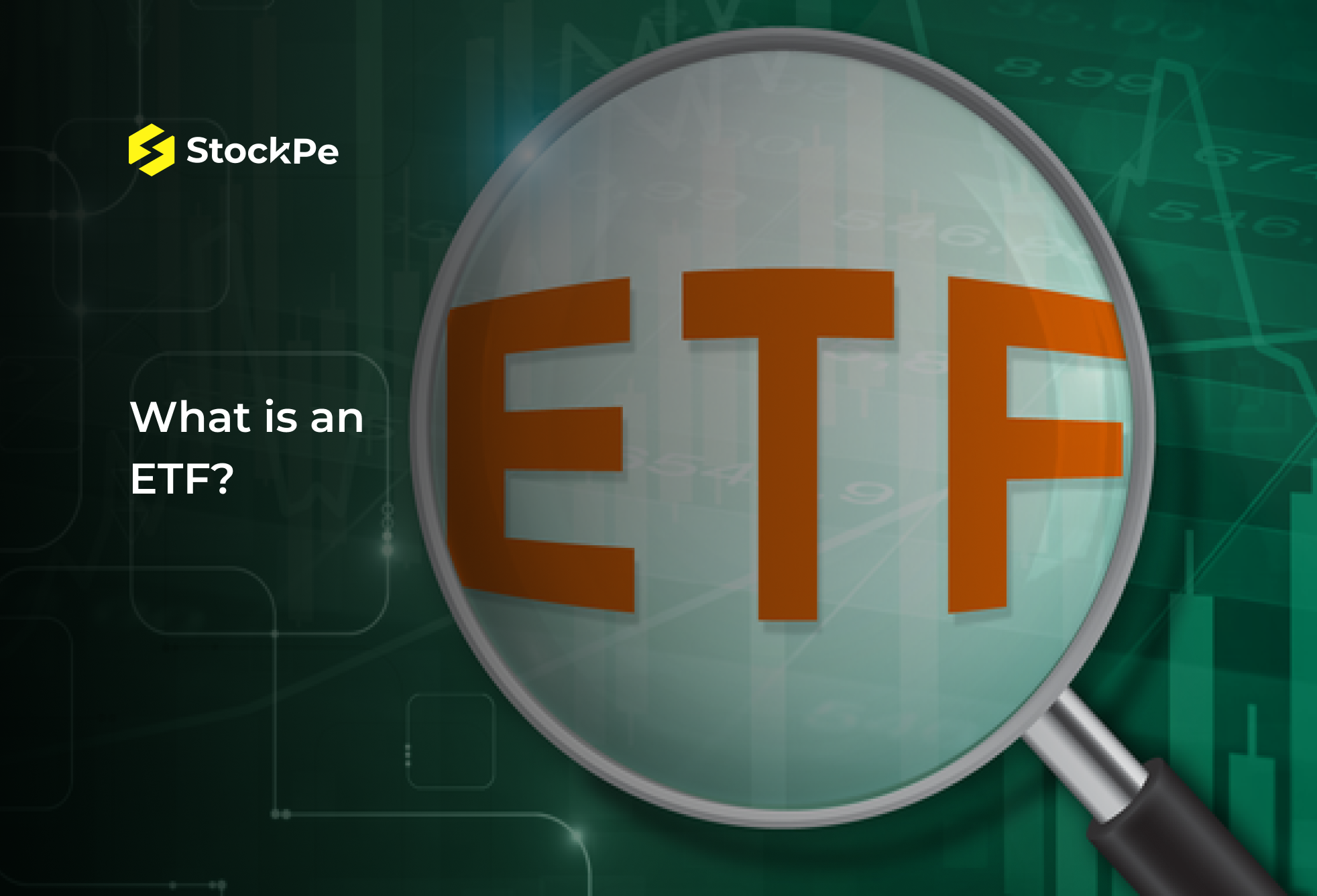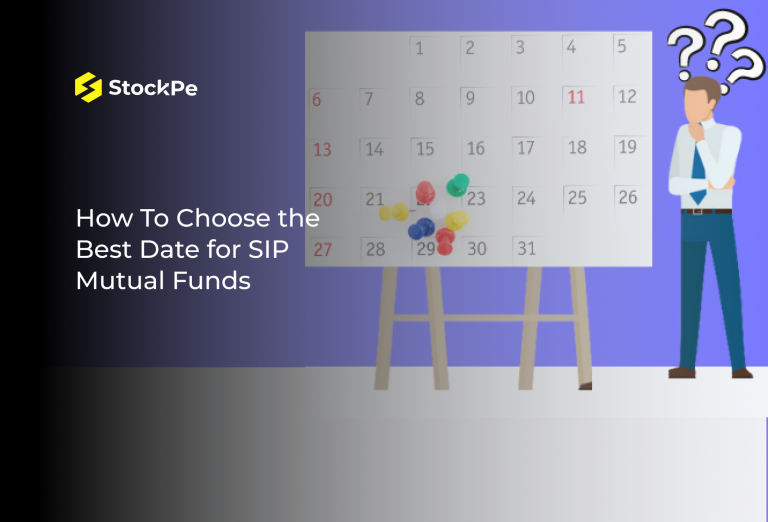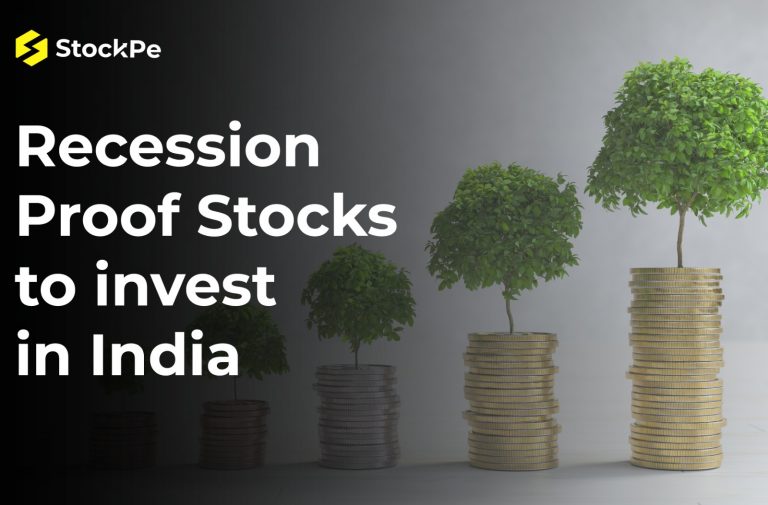ETFs or exchange-traded funds are a bunch of funds that trade on various exchanges, generally tracking a specific index. When you buy an ETF, you receive a bunch of assets clubbed together that you can buy and sell during market hours, lowering your risk and exposure while helping to diversify your portfolio. An ETF can be an excellent investment, provided it’s done the right way. In this article, we’ll learn how an Exchange Traded Fund or ETF works, ETF types, Its advantages, ETF vs Mutual funds, and much more.
How do ETFs Work?
Before anything, we must understand how ETFs work. ETF’s working mechanism is quite simple. Firstly, there has to be a fund provider. The fund provider owns the underlying assets. The fund then forms a fund to track performance and offers shares in that fund to investors. Shareholders can own a part of an ETF but not the entire ETF.
An ETF provider considers all types of assets, such as stocks, commodities, bonds, or currencies and then creates a basket of them. Investors can buy a share in that basket like they would purchase shares in a firm. Just like stocks, buyers and sellers trade ETFs on an exchange.
Buying ETFs
ETFs are traded through brokers (online) and traditional broker-dealers (offline). Many sources provide pre-screened brokers in the ETF industry. Individuals can also purchase ETFs in their retirement accounts. An ETF’s expense ratio stands for the cost to operate and manage the fund. ETFs typically have low expenses because they track an index.
ETFs are generally available on almost all online investing platforms, retirement account provider sites, and investment applications and platforms. Most of these platforms offer commission-free trading, i.e., investors don’t need to pay fees to the platform providers to
trade ETFs.
After creating and funding a brokerage account, investors can search for ETFs and make their chosen buys and sells. One of the best ways to narrow down ETF options to choose from is to utilize an ETF screening tool with criteria such as trading volume, expense ratio, past performance, holdings, and commission costs.
What Are The Types of ETFs?
- Passive ETF: These aim to mimic the performance of a broader stock market index like a diversified index such as the National Stock Exchange (NSE) or a more specific targeted sector or trend.
- Actively managed ETFs: These do not target an index of securities but have portfolio managers who actively make decisions about which securities to include in the portfolio. They have benefits over passive ETFs but can be more expensive to investors.
- Currency ETF: Track the performance of currency pairs consisting of domestic and foreign currencies. Currency ETFs can help in speculating currency prices based on Socio Political and economic developments in a country. They are also used to diversify a portfolio or hedge against volatility in forex markets by importers and exporters.
- Inverse ETF: Earn gains from stock declines by shorting stocks. Shorting is borrowing a stock, selling it while expecting a decrease in value, and re-buying it at a lower price. An inverse ETF takes recourse to derivatives to short a stock. Inverse ETFs are called exchange-traded notes (ETNs) as they are not true ETFs.
- Industry or sector ETF: Funds focusing on a specific sector or industry. An energy sector ETF includes companies operating in that specific sector. ETFs that track individual industries and sectors such as oil (OIH), energy (XLE), real estate investment trusts (IYR), and biotechnology (BBH).
- Commodity ETF: Invest in commodities like crude oil or gold. Commodity ETFs can diversify a portfolio, making it easier to hedge market downturns. Holding commodity ETF is also cheaper than physical possession of the commodity.
- Stock ETF: The aim is to provide diversified exposure to a single sector, including high performers and new entrants with good growth potential. Unlike mutual funds, ETFs generally have lesser fees and do not involve actual ownership of securities.
- Bond ETF: This type of investment provides regular income to its investors. These may include government, state, corporate and local bonds, usually called municipal bonds. Unlike their underlying instruments, bond ETFs have no maturity date.
- Bitcoin ETF: The spot Bitcoin ETF was approved in 2024. These ETFs expose investors to bitcoin’s price moves in their regular brokerage accounts by purchasing and holding bitcoins as the underlying asset and allowing them to buy shares of the fund.
- Leveraged ETF: A leveraged exchange-traded fund (LETF) is a security that uses debt and financial derivatives to increase the returns of an underlying index or other assets it tracks. A leveraged ETF returns some multiples on the return of the underlying investments
CTA– Before investing in types of ETFs, Consult with a market expert advisor or utilize stock market advisory services to get valuable insights and make informed investment decisions.
Differences Between ETF Mutual Fund and Stock
Here are the top 10 differences between mutual funds, ETFs and stock, along with their structures, investing strategies, expenses, and other essential considerations when deciding between the two. Understanding these variations is essential for making educated investing decisions and matching investment choices with personal financial objectives.
| Feature/Aspect | Mutual Fund | ETF | Stock |
| Pricing | Prices once a day after market close | Prices fluctuate throughout the day | Prices fluctuate throughout the day |
| Purchase and Sale | Bought and sold through the fund company | Traded on an exchange like a stock | Traded on an exchange |
| Minimum Investment Requirements | May have minimum investment requirements | No minimum investment requirements | No minimum investment requirements |
| Tax Efficiency | Less tax-efficient due to the structure | More tax-efficient due to the “in-kind” creation and redemption process | No specific tax advantages |
| Expense Ratios | Typically have higher expense ratios | Typically have lower expense ratios | No expense ratios |
| Disclosure of Holdings | Disclose holdings quarterly or semi-annually | Disclose holdings daily | No regular disclosure requirements |
| Investment Strategy | Investment strategy may be active or passive | Mostly track indexes (passive) | Individual company performance |
| Short Selling and Margin Buying | Cannot be sold short or bought on margin | Can be sold short and bought on margin | Can be sold short and bought on margin |
| Sales Loads | Often charge front-end or back-end sales loads | Do not charge sales loads | No sales loads |
| Liquidity | Might be subject to liquidity risks | Generally have better liquidity due to intraday trading | Generally have good liquidity due to intraday trading |
| Ownership | Represents a share in a diversified portfolio | Represents a share in a diversified portfolio | Represents ownership in a single company |
Apart from ETF, Mutual funds and Stocks, there are various other types of investment in a stock market. Click here to find out.
The Role of Diversification in Mutual Funds and ETFs
Diversification is a critical component of both mutual funds and ETFs. By spreading investments in various asset types, sectors, or regions, diversification significantly helps to mitigate risk.
Mutual Funds: By pooling money from numerous investors, mutual funds (MF) can invest in a wide variety of securities, providing instant diversification. This is quite beneficial for investors with smaller amounts of capital.
ETFs: Like mutual funds, ETFs offer diversification. However, the extent of diversification can vary significantly between ETFs, with some ETFs tracking broad market indexes and others focusing on specific sectors or themes.
Advantages of ETFs
| Feature | Description |
| Easy to trade | You can trade in ETFs any time of the day, unlike most mutual funds that generally trade at the end of the day. |
| Transparency | Most ETFs are required by regulatory bodies to publish their holdings on a daily basis. |
| More tax efficient | ETFs generally generate a lower level of capital gain distributions compared to actively managed mutual funds. |
| Trading transactions | Because they’re traded like stocks, investors can place a variety of order types, for example, limit orders or stop-loss orders that can’t be made with mutual funds. |
Disadvantages of ETFs
| Feature | Description |
| Cost of trading | If you invest in little amounts frequently, there can be other lower-cost alternatives investing directly with a fund company in a no-load fund. |
| Not very liquid | Some thinly traded ETFs have large bid/ask spreads, which can involve the risk of buying at the high price of the spread and then selling at the lower price of the spread. |
| Error tracking | While ETFs track their underlying index quite well, technical issues can create discrepancies. |
Are ETFs good for beginners?
ETFs are extremely popular because they offer investors a lot of value and that’s especially good for beginning investors. The minimum price for ETFs is usually the price of just one share, which can vary sometimes. If we compare that with the minimum initial investment for a mutual fund, it’s quite less and affordable. Some brokers often allow you to buy fractions of shares, so one does not even need enough for a full share to get started.
ETFs also allow interested investors to invest into an investing theme, even if they barely know about it. For instance, If you’re not a manufacturing expert, a focused manufacturing sector ETF will give you exposure to the industry. You would not need to pick and choose which companies are the winners. Beyond thematic investment, many brokers allow you to trade in ETFs without any commission.
One of the best things about ETFs is that they offer instant diversification. If you wish, you can invest in a single fund and own a specific bunch of companies that are focused on a particular area of the market or the market in general. In either case, you diversify your portfolio reducing risk associated with it.
Finally, ETFs offer you to buy popular indexes that lets you “own the market” and get the market return, which can be averaged about 10-15 percent annually over time.
FAQs
Q. Which ETF is best in India?
Choosing the best ETF in India depends on your investment goals:
- Nippon India ETF Nifty 50: Best for broad market exposure through top 50 NSE companies.
- Nippon India ETF PSU Bank: Ideal for those bullish on public sector banks.
- BHARAT 22 ETF: Offers a diversified portfolio of public sector enterprises.
- Mirae Asset NYSE FANG+ ETF: Great for exposure to top global tech giants.
Q. Is ETF safe to invest in?
ETFs can be safe investments if done properly as they offer diversification and flexibility. Indexed ETFs, tracking specific indexes are generally safer and gain value over time. Leveraged ETFs on the other hand can be used to amplify returns, but they are also riskier due to increased volatility.
Q. Is gold an ETF?
Gold ETFs are a type of commodity funds that are traded like stocks and have become quite a popular form of investment. They are made of assets that are backed by gold, investors don’t physically own the actual commodity.
Q. Can I sell my ETF anytime?
There are generally no restrictions on how often you can trade stocks, or ETFs. You can invest as little as Rs. 1000 with fractional shares, there is generally no minimum investment and you can do trades throughout the day, rather than waiting till the end of the trading day.
Wrapping up!
ETFs have become quite popular in the last few decades, and this popularity will only become higher in the coming time. Among the most popular investing strategies, buying and holding an NSE or BSE index fund has been recommended by various legendary investors such as Warren Buffett. While the influx of cash to ETFs can go a little down when the market fluctuates, the long-term trend of ETF investing looks clear.
Do you want to be an expert at ETF investment? Contact us now at support@stockpe.in





